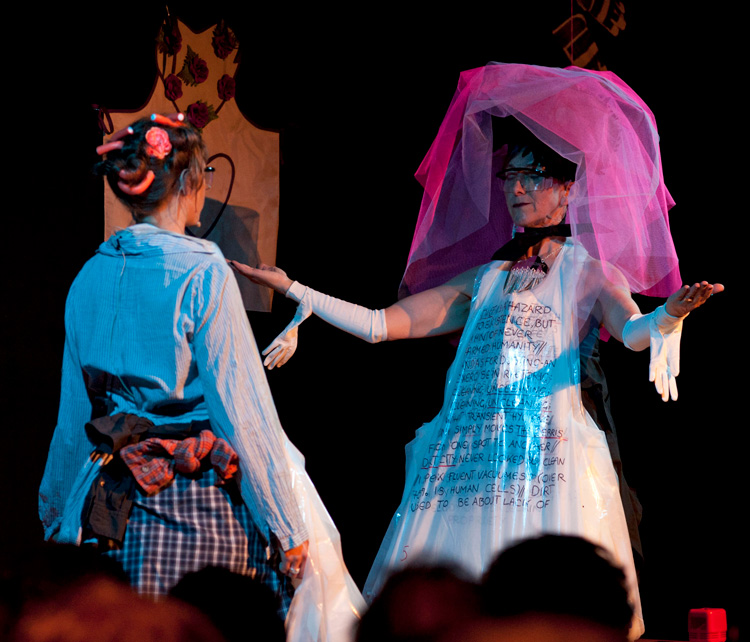
Silvia Ziranek with Isobel Dunhill in Not Undirty, performance, Wellcome Collection, 2011. Photo: Heather Tait.
by KATY DEEPWELL
Who is Silvia Ziranek? Born in Chelsea in London, she began a degree in Russian and Arabic at the University of Leeds before leaving to study fine art, first at Croydon College of Art, then at Goldsmiths from 1973 to 1976. Her witty performances have opened galleries, launched events and been seen at numerous festivals, with readings of her texts in venues internationally. She is part of the same generation of innovative and independent women performance artists from the UK as Bobby Baker, Rose English, Anne Bean and Rose Finn-Kelcey. Her latest exhibition, It Is Is It, at One Canada Square, Canary Wharf in London (8 July – 16 August 2019) was a mini-retrospective focused on the badges she frequently produces to hand out at her performances. For the exhibition, these 1in (2.5cm) badges were reproduced on a large scale (1 metre), printed on vinyl, and displayed on the walls like icons or logos. To set the context for these, the exhibition display included texts, outfits, artefacts and photographs of Ziranek’s performances from 1986 to 2019. This interview took place while walking around the exhibition, discussing many different performances in her oeuvre.
Katy Deepwell: Why is the show called It Is Is It?
Silvia Ziranek: It’s a convenient title. It’s eight letters, which resolve into a good visual block. The exhibition is theoretically all about the badges, about labelling, about presentation. It’s about encompassing the idea for the works I make on to a 1in diameter metal disc, which I generally give away to people. It’s about how you distil something, how you wear something. It’s about the identity of the badge and the wearer, but then also about questioning it.
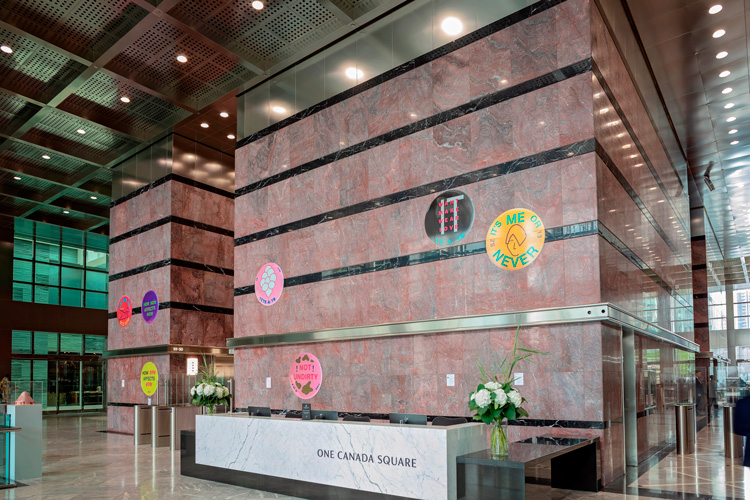
Silvia Ziranek, It Is Is It, installation view, Canary Wharf, 2019. Photo: Verdi Yahooda / Stephen White.
KD: Have you made a badge for every performance you have done since the mid-1980s?
SZ: No, not at all. There are about three dozen badges here. This represents less than half of the performances I’ve done, ie texts I have written. I love the writing. I also love the designing. I like to make an emblem to encompass not the essence, not necessarily the significance even, but the title of a piece of work. The title is always very useful for me as a springboard, a launch pad, a door, even a letterbox, to start off the whole thought process. I like putting together the shapes and the colour: designing. I love having a pencil in my hand.
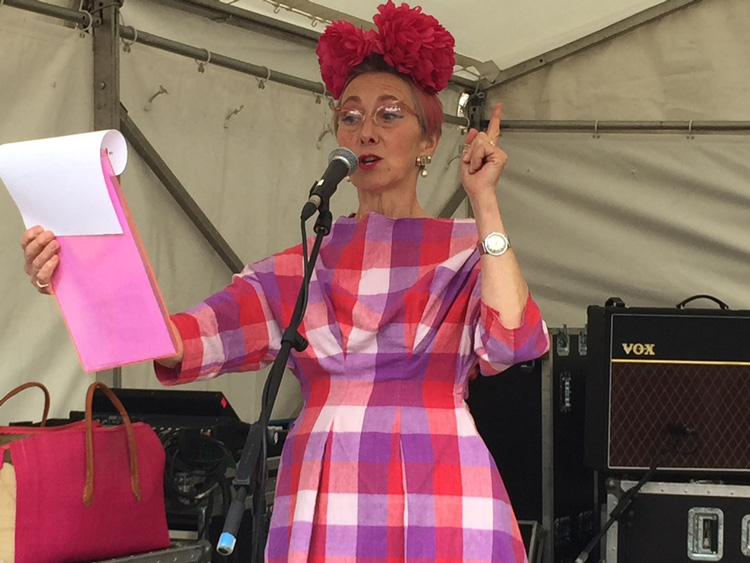
Silvia Ziranek reading a selection of her writing at Art Car Boot, Cabaret Futura programme, London, 2015. Photo: Chrissy Robinson.
KD: You have placed some of these designs on plates and saucers. The circular design of the badge works well as a transfer to these media.
SZ: I agree. We – the curator, Ann Elliott, and I – were trying to think of ways to extend the round shape of the badge design: to biscuits, hubcaps, umbrellas. I thought that mugs with lids were delightful and very personal. When I had my first baby, one thing I could not accept was cold tea, so I had a mug with a lid. It’s very me. It’s my own little culinary demand.

Silvia Ziranek, collection of badges from performances 1989-2019. Photo: SZ.
KD: How did you settle on the orange and blue with the dark red text?
SZ: It’s actually a pink. There has to be a little bit of pink! I had to think about all previous badges and which colours not yet used. Mustard and fuchsia are delicious together, but I had used these in the badge for The Pompom Years (Victoria and Albert Museum of Childhood in Bethnal Green, 2009). The colours are lovely, but you need strong colour contrast on a badge of 1in diameter. I like giving them out. Is it better to give than to receive? It pleases me when people say that they have a collection of the badges of my performances over the years.
KD: In this exhibition space, we are surrounded by a busy shopping centre and office culture, where branding is everything. Yet the circular shapes in your badges don’t really function as logos or a brand, even when you incorporate your initials, SCZ or SZ. They have a kind of post-punk DIY quality. They are not really advertisements or marketing material, more souvenirs or gifts from the event.
SZ: Post-punk, I would like that! That means that I am unbrandable!
.jpg)
Silvia Ziranek, Anyone Can Apron, Kettle’s Yard, 1987. Photo: Verdi Yahooda / Stephen White.
In Anyone Can Apron (Kettle’s Yard, 1987), the writing is around the outside with the picture of the huge hammer on the petite ironing board in the middle, hand-drawn. I was playful with scale, like in a miniature doll’s house. The symbolic hammer and sickle were reconfigured in this badge in a non-sexist, non-hierarchical, non-racist way. Though there’s always going to be a little hierarchy!
When I travelled from Addis Ababa in the late 1970s west to the coast, up the Red Sea through Israel and back to England with a convoy of VW Dormobiles, in one of the heterosexual couples on this trip, the man did the dusting and the cooking and the woman put on the white overalls and tended to the mechanics. This swapping of traditional roles encapsulated for me that anyone can do anything with endeavour and determination (and pressure, if need be).
When I was at college, I made a silkscreen print substituting the hammer with a stiletto shoe for another performance, Soviet Sensation (1976), which was a long series of beautifully poetic questions: “Can you … Would you … Did you? ... Have you?” Questions not about silliness, but about the essence of a person and what reasonable lengths would you go to, to do, to be, to have, to think.
.jpg)
Silvia Ziranek, Vitrine of objects from two performances, Dress Messages, Bury St Edmunds Art Gallery, 2004 and I Are Or, Imperial War Museum, 2007. Photo: Verdi Yahooda / Stephen White.
KD: The exhibition contains several of the costumes you have made for your performances, including I Are Or in Camouflage (Imperial War Museum, 2007), for which large photographs of you are also shown.
SZ: They’re more outfits than costumes. I think costume is a slightly gaudy description. Perhaps I am a little gaudy, but I like colour. I like shape. I like form. I made the outfit entirely myself, except the hat, made by Stephen Jones, designed for me to accompany this outfit. The bulk of the fabric on my torso is from Osborne & Little, the furnishing fabric company, which has frequently sponsored me. I like substance, which is why I chose these sturdy fabrics. There are certain people who think a clown will wear camouflage, but I am definitely not a clown and I definitely don’t wear camouflage. I enjoy appearance and colour and shape and form – and I love dressing up. These are not very English attributes.
.jpg)
Silvia Ziranek, outfit for The Pompom Years, Victoria and Albert Bethnal Green Museum of Childhood, 2009. Photo: Verdi Yahooda / Stephen White.
I deal with fabrics and I deal with words, in a very personal way. Sometimes I’m understood and sometimes I’m indulged. Sometimes I’m appreciated and sometimes people find me completely confusing and sometimes irritating. I get immersed in vocabulary and a sort of communication that involves much more than words. It’s a way of thinking, of thoughts and literary endeavour and of emotion, because there is very little in my work which is not autobiographical.
KD: Did you see this costume as a form of alternative camouflage. Camouflage is usually about blending in, but this is a way of standing out from the crowd?
SZ: No, completely not. That had not occurred to me. I could hardly be said to be employing camouflage in any form of existence. I do not dress for others, though I do not dismiss – or avoid – attention.
KD: So, it’s about camouflage as duplicity.
SZ: Triplicity even.
KD: Form versus function?
SZ: Yes, and form and function. If food is good, if clothes are good, if life is good, it can blend the two things (form and function) together. It doesn’t have to be a confrontation. There is no irony in my outfits, but in my performance A Few Big Frocks, made for the Frida Kahlo conference that took place at Tate Modern in 2005, you might imagine total irony when, in the performance, I wear 10 fabulous full-length aprons in vivid materials, each one put on over the last. The apron epitomised the layers of Kahlo colour and character as I was able to empathise. I try to make the most of each sartorial occasion. There is practicality in I Are Or as there are trousers underneath the very flouncy skirt that could well keep me warm if need be.
.jpg)
Silvia Ziranek, outfit from Most/ly Motif/ly performance, Crafts Council, 2002. Photo: Verdi Yahooda / Stephen White.
KD: When I look at this costume, it reminds me of Russian constructivist outfits for plays such as Victory over the Sun (1913). Is this an influence?
SZ: Possibly. Everyone has lots of cultural influences, including many derived from nature, which are unfathomed and endless. If we began to understand how nature influences us, we would all be in a much safer world.
When I presented the Not Undirty performance in the Wellcome’s Dirt programme in 2011, I undertook a lot of research on personal hygiene, on consumer promotions, on sewage and refuse collection, on approaches to using chemicals – and this was before many people became so concerned by the plastic nodules that are going into all life forms and the oceans.
I like seeing different colours, different shapes, different textures of fabric. I like to wear a text, for example, which we actually did in Not Undirty: our words were printed on our disposable aprons. This is a way of wearing in the performance what I am and how I am. I revel in appearance. We’re all individuals and it depends on how confident one is in one’s appearance that one allows oneself to be and how one almost pushes oneself to be. What do they say these days, “I’m claiming my space”? It would be a lost opportunity, if I didn’t dress myself.
I also find it impossible to throw anything away. I still have pantyhose from when I was 15. I do mend. I can make clothes, change zips. I put fabric on the ground, chalk something out, then sculpt it to myself. These days I spend far too little time creating clothes and have far too many fabrics.
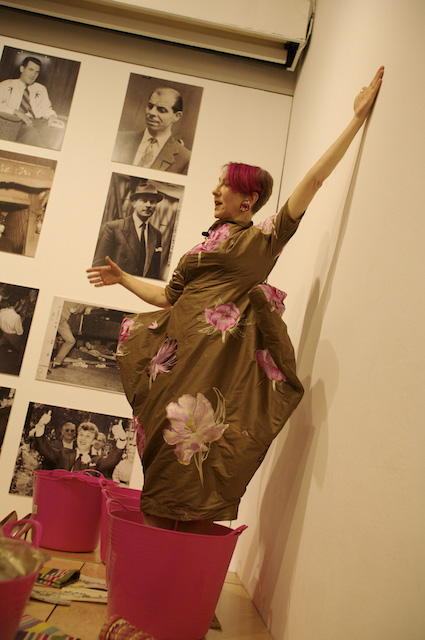
Silvia Ziranek, Wall Walk, performance, The Photographer’s Gallery, London, 2008. Photo: Clare Grafik.
In the performance Wall Walk at the Photographers’ Gallery in 2008, commissioned for the gallery when it moved from its split sites by Leicester Square to its new single site behind Oxford Street, I designed and made an outfit from Osborne & Little fabric with an enormous collar and cuffs. Each performance requires a new outfit. Andrew Logan kindly made buttons for the outfit but, because he thinks things through, he also made some clip-on earrings because he imagined or considered my earlobes would need some glorification and it would be absurd if my ears were not part of the whole!
KD: Sponsorship in kind has not just been part of how the work is made, but also a subject of the work?
SZ: Yes. Logo Lingo (Serpentine Gallery, 1990) is entirely, in essence, about the importance of sponsorship to art and artists and about how the use of sponsorship could alter a piece of work for better or worse. One sponsor gave two cans of water face spray of “next to nothingness” while BMW loaned a 650cc motorbike (for many years, I was an ardent biker) and gave a helmet. I entered on a motorbike, roaring into the gallery and placing it on a stand, taking off the helmet, putting on Stephen Jones millinery and then putting on the next headwear by Presents. My outfit was a kimono-type dress, silk from English Eccentrics, and the shoes were from Red or Dead. At the time, this form of sponsorship in kind was just starting to come into the art world in the UK in a major way. There was a beer brand that wanted to be my “only” sponsor, but for this show it was about a plethora – an excess – of sponsors, as many as I could involve. This was about questioning the limits of authority between the sponsor and the artist. The work explores how receiving sponsorship could or would influence what you were doing, even if it was a gift in kind, even when it was not considered practical, even down to the paint for the colour of the walls and the furniture, because all can affect your state of mind.
.jpg)
Silvia Ziranek, Vitrine in It Is Is It, three publications of Z in W (Anyone Can Apron), performance, Plug In, Winnipeg, Canada, 1989 and sponsors’ acknowledgements for Logo Lingo, Serpentine Gallery, 1990. Photo: Verdi Yahooda / Stephen White.
KD: Is your use of pink ironic, as it so frequently recurs in your outfits and your work? Pink is that ultimate girly colour.
SZ: Well, I don’t see it as either an area of attack or defence. I love pink. It stops me feeling wretched. I find it the most joyful colour, the most vibrant eye-catching colour. Whenever I see pink in a car boot sale – where I spend an inordinate amount of my Sunday time and a modest amount of a little money – I have to stop and look at whatever it is. Mostly, I wear pink and I know what I look like. It’s nice to get compliments, but this is not why I wear what I do. There are occasions when I go out just wearing a T-shirt and a pair of shorts and some sneakers, but I will put on earrings – and the blue eyeliner!
KD: Is there a little “resistance” in this pink?
SZ: You’d like me to say that, but no. More recently, I’ve been making badges from newspaper headlines – usually staunch, not aggressive, sort of survivalist statements from and for women, although I’m imagining them as descriptions by or of women – cutting them out, laminating them, applying them to a brooch or necklace and wearing them. I was thinking of calling that brand “Pink Skirt”. Now that would be irony! Yes, this is what I do and I am Woman. I am a female woman and I am a heterosexual fully-bodied and -abled woman etc, etc and I do wear skirts and I know which end of a monkey wrench to hold before I employ it on my dying plant!
KD: This pink theme and wearing of texts is very evident in another piece, Dress Messages (for Art Textiles 3, Bury St Edmunds Art Gallery, 2004).
SZ: Although I did not wear much pink on that occasion. In that work, I had a hat by Stephen Jones, a cape, a one-piece of malleable fabric, fitted just above the shoulders with long sleeves and divided into trousers. I had two mannequins for that performance: I put the hat on one and the cape on the other. I had 12 bags (with other bags inside them) that I gradually emptied, taking out of these smaller, inner bags the messages that I then read out and pinned to the cape on one mannequin. The messages were the entire text of the performance, about death, about smell, about conformity, about cost, colour, comfort: “Comfort Helps. Design Is Completed By Comfort” The smaller, inner, bags were hooked on to the second mannequin.
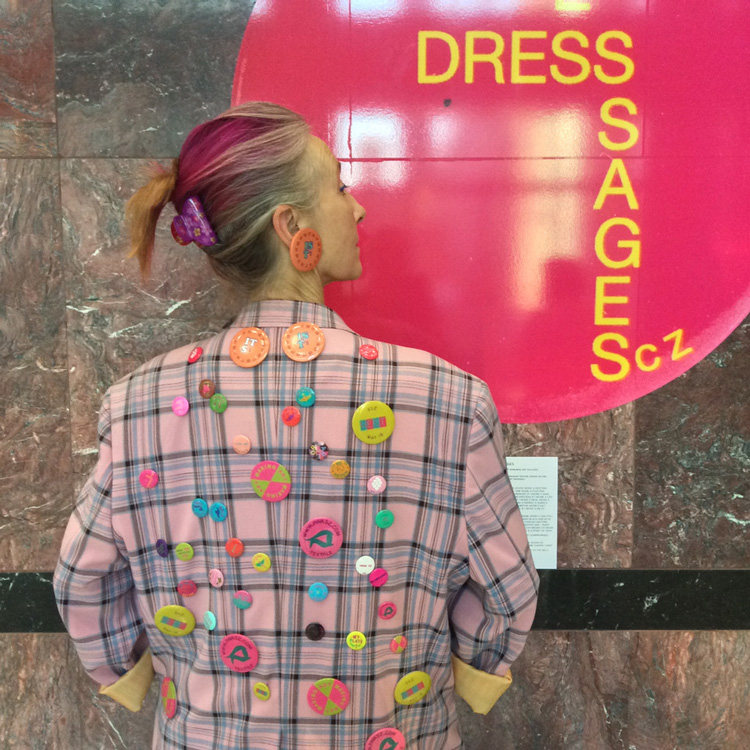
Silvia Ziranek in front of Dress Messages badge, Canary Wharf, 2019. Photo: Silke Dettmers.
At the very end of this performance, when I was again wearing the cape, I swirled it around so you could hear all the Chinese paper on which the messages were written rustling and you could smell it (I had sponsorship of my favourite Shiseido perfume). The whole performance was about how clothing can affect one, what kind of clothes you can afford, whether it’s comfortable, biodegradable, old or new. This performance was also about what clothes smell like, how they make you feel, how they taste. It was about the senses, how you look and how you perceive other people look and how they react to you when they see what you are wearing, and the impression that clothing makes on someone.
My daughter took part in the performance, knitting like Madame Defarge, from Tale of Two Cities, wearing an outfit my mother had made for me when I was 10 years old. The last line was “Come, Fifi – I wish to wear my diary to the ball.” My daughter had a little handbag she called Fifi, but that line also came from the International With Lipstick exhibition/installation/performance (Anthony Reynolds Gallery, 1986), where we had a postcard made up with “I wish to wear my etc, etc”. This fine card was deemed too much to contemplate by some!
KD: I was trying to identify how you operate with wordplay, and it seemed to me you play with the absurdity of language and explore it in your works.
SZ: There are two things here. And I don’t mean this as a confrontational challenge. I use language rather than play with it. As far as declension, conjugation etc go, I love grammar. I went to university to study Russian and Arabic. My father was Polish and I was urged into a similar, more useful language at the time. I love declension. I love conjugating. Vocabulary is who one is. I don’t think of this as play unless “play” can mean life. I know you can play in earnest. It’s a deep investigation, not an indulgence. It’s like going into the core of communication as far as words and etymology are concerned, changing a noun into a gerund, questioning the use of familiar language by making a verb into an adjective. For me, this enriches a phrase or a description, beyond any sort of communication. Because I understand what I write intimately, this increases the enjoyment of sound, because there is alliteration and syncopation. Poetry. There’s a shape to the sound in my work, which isn’t necessarily onomatopoeic at all. Language is my medium. I do bring in a little bit of German, sometimes French or Russian or Italian. I never strive to be “clever”, that’s not what I develop. I enjoy and depend on thinking and pondering and delving until I harness precision. There are very few times I will post-edit anything that I’ve written. Also I don’t learn any of my words/text for a performance, I read them – from disposable knives catapulted over the audience, from edible paper, from ever-decreasing circles on my hands, from flowers falling from an umbrella opened. This is not just about memory, it’s because I would then be an actor; this is important to me. I’m not portraying another character, I am me. Every single precise word is read as written, how I finalised the text. And I frequently only ever present a text in performance once.
KD: You tackle a lot of serious issues in the interplay between meaning and absurdity in your work, often using colloquialisms, common phrases. The performances, however, mix these things together: meaning, absurdity, message and cliches. You use humour a lot as well.
SZ: I’m not sure I use that many cliches but, when I do, I turn them around and give them a twist to prompt and provoke a richer, slightly more obscure/heightened meaning. I think my use of words is very similar to my use of clothing and fabric. People may dismiss me because I’m very visible, which does not seem to be something that people embrace with any joy in England right now. In so many ways, it’s because we do live in a very “beige” culture. I find more sustenance from really good architecture and from textiles than most art that I look at.
KD: You often point to many small details in daily life to highlight its absurdity, even to things that are on the edge of vision.
SZ: That’s really reassuring for me to hear because it means that it causes you to think – not that you wouldn’t think anyway. Sometimes the curiousness and the anomalies in how I use the English language – and the sheer sounds – mean people will just listen. In the work Declining Silence (Tate Modern, 2009), for a programme for people who could not hear or were hard of hearing, the performance was saying “no” to silence as in no to a silence of communication, but also a grammatical silence. At the end of this event, the audience waved their hands in the air, as clapping hands can be harsh and inaudible for deaf people as they would feel it but not hear it.

Silvia Ziranek, large vinyl badges from Declining Silence Tate Modern performance, 2009. Photo: SZ.
The two badges have the hand signs for “N” and “O”. Each time after this performance I have requested a British Sign Language interpreter to work with, to open up what I do to as many people as much as possible. Signing is outrageously unusual in the public context. I have one favourite signer, Jeni Draper, who reads the text beforehand in order to prepare her signing and expressing it. This performance was also about the senses: everyone got to take home the badges, the fancy cakes, they got the unguent shower gels, and they all got the dear little jack-in-the-box-type publication I made so that, during the performance itself, they could follow the sign language and they could follow the huge texts behind me on the wall, they could then follow the text on their own at a later stage.
KD: You have described the multisensual aspect of the performances – you make multiple peripheral objects for each performance, it’s not just the clothes or the badges, or even just the text/voice in the performance.
SZ: Yes, but these objects are not just peripheral. I’m a very crafty person. I love using my hands. When I did the performance The Pompom Years, it was for the Children’s Fashion Through the Ages programme at the Victoria and Albert Bethnal Green Museum of Childhood. I was imagining anyone who smiled at the thought of a pompom in their childhood. Now pompoms are really popular again, particularly in winter time. I am always so anxious about my text until after I have presented it for the first time. I always think it might be half-hearted, inadequate. It was only after I had finalised the text for the performance that I made up the prototype publication as a pompom bonnet with the performance text inside it. I love making things and I don’t do this often enough. I love making, I love drawing and designing. I find it extraordinarily soothing to sit at my sewing machine, the only time I really feel at home and secure – and this is almost bringing me out in tears now – is when I sit at my sewing machine. And I know what I’m doing. I use different fabrics, I use rubber and plastic and paper, even though at the moment I’m using more silks and cottons. For me, it’s not experimental, and maybe it’s unusual, but I really feel secure in what I’m doing and how I’m doing it. If the tension goes haywire on the sewing machine (rubber is a nightmare), I rethread! To do more making would be very, very good for my soul.
KD: Much of your work has concentrated on live performances. Most are well documented, and the texts or objects remain, what is your approach to live performances?
SZ: I’ve probably thought about this question far too little. I get really moithered when I can’t find the original text of a performance. As yet I don’t have a filing system for them. Also, please remember these are texts, not scripts, as I’m not acting. If someone else were to present them, they would be acting and, for them, it would be a script. I’ve never had a problem with anyone photographing my performances so long as they do not get in front of anyone watching it. I am quite careful about the resulting photographs. As far as subject matter, there are few issues I won’t work on. I say I don’t do parasites, but, then again, some of that behaviour is involved in exploring emotion and dependency. There is in my overall oeuvre a sense of what I will and how I will do things.
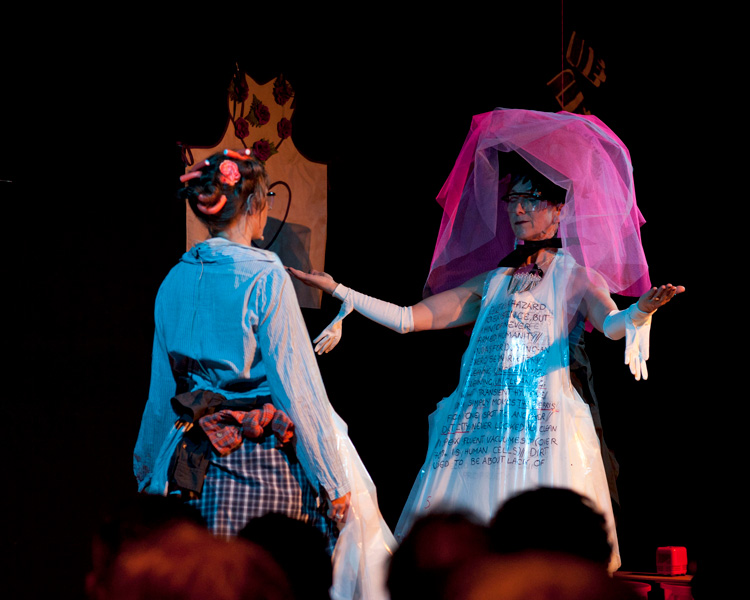
Silvia Ziranek with Isobel Dunhill in Not Undirty, performance, Wellcome Collection, 2011. Photo: Heather Tait.
KD: In the 2000s, you started to collaborate with several younger women in your performances – for example, Not Undirty and Most/ly Motif/ly (Crafts Council, 2002).
SZ: Yes, and I find this quite difficult. My collaborator in these two works was a highly intelligent, and very attractive, person who, once in front of people, stood stock still and smiled beautifully, almost beatifically, almost forgetting that we were involved in some earnest endeavour. I’ve also been working on a series of poems, Unsung Songs, which had been written for/by one voice: mine; and then expanded for performance, so I began working with another woman, a much younger woman, who hasn’t necessarily – hopefully - the same experience/s – that I have. Mostly, I don’t like to have to explain what constitutes many women’s experience, though that is what constitutes Unsung.
KD: I think you often write about the difference between being/feeling and doing.
SZ: Yes, in I Th!nk Nøt (Freud Museum, 2013), there is a great deal of humour. This is where the “being” comes in. I had a yoga teacher who told me once, “Wherever you are, just be there” and I thought it was risible, laughable. However, many years later, I begin to understand it. I can’t do it, however, as I’m too nervous. The programme was Totem and Taboo. I thought I would deal with areas which are not “nice” in this work. I wanted to introduce in covert terms the reasons why something was unpleasant, unacceptable, taboo. What you don’t want to see is someone coming out of a bathroom wiping their hands on their trousers – this is too obvious for me – but why call a spade a spade, why not call it a horticultural investigatory implement? It’s not because I want to complicate things, but we are given language as a tool of civilisation as well as communication: it’s not because the more polysyllabic a word, the more refined, though succinct vocab attracts me. Visually, I had a belt of lipsticks; as I pronounced out each undesirable area I applied lipstick – to my lips - in ever increasing hue and size; by the end my “mouth’ covered my entire lower face.
To go back to the seriousness of the content, some of my work is undeniably dismissed because of humour and colour, yet it is undeniably witty. And true. I live/d it. Each of my texts, most of which have gone into performances – although some have been also been published as texts – at core are about how life can be inordinately serious. I struggle to survive much of the time; it’s a challenge. I don’t think I have found my entire salvation through writing, but everything I do write about I do think about deeply. If deep is serious and truth translated, much is “serious”.
• An ebook of Silvia Ziranek’s texts, Wall Works: Selected Writings and Performances, is available from KT Press.
![David Hammons. Spade (Power to the Spade), 1969. Body print, pigment, and mixed media on paper, 53 1/4 x 35 1/4 in.
Collection of Jack and Connie Tilton, New York. [On view at Grey Art Gallery, NYU].](/images/articles/b/black-performance-2013/smallpix/1_Hammons_Spade_1969-300.jpg) Black Performance as Visual Art
Black Performance as Visual Art